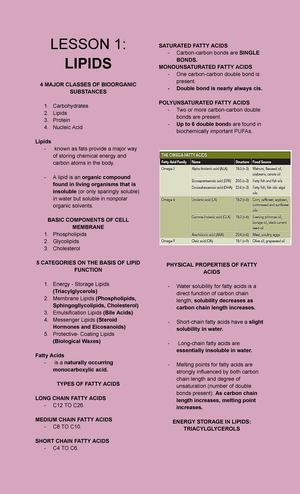- Information
- AI Chat
This is a Premium Document. Some documents on Studocu are Premium. Upgrade to Premium to unlock it.
Was this document helpful?
This is a Premium Document. Some documents on Studocu are Premium. Upgrade to Premium to unlock it.
Carbohydrate Metabolism (LEC)
Course: BIOCHEMISTRY (CHM3)
365 Documents
Students shared 365 documents in this course
University: Our Lady of Fatima University
Was this document helpful?
This is a preview
Do you want full access? Go Premium and unlock all 6 pages
Access to all documents
Get Unlimited Downloads
Improve your grades
Already Premium?

CARBOHYDRATE METABOLISM
RECALL: Different stages of metabolism
1. Digestion
2. Formation of Acetyl-CoA
3. Krebs Cycle
4. Electron Transport chain and Oxidative
phosphorylation
DIGESTION OF CARBOHYDRATES
Carbohydrates, especially glucose, play major roles
in cell metabolism.
The major function of dietary carbohydrates is to
serve as a source of energy.
-In a typical diet, 2/3 of daily energy needs are
furnished by carbohydrates.
-During carbohydrate digestion, disaccharides and
polysaccharides are hydrolyzed to form
monosaccharides, primarily glucose, fructose, and
galactose:
-After digestion is completed, glucose, fructose, and
galactose are absorbed into the bloodstream
through the lining of the small intestine and
transported to the liver.
-In the liver, fructose and galactose are rapidly
converted to glucose or to compounds that are
metabolized by the same pathway as glucose.
BLOOD SUGAR LEVELS
Glucose is the most plentiful monosaccharide in
blood. The term blood sugar usually refers to
glucose (food of the cell)
In adults, the normal blood sugar level measured
after a fast of 8-12 hours is 70-110 mg/100 mL
(in clinical reports the units are in mg/dL).
The blood sugar level reaches a maximum of about
140-160 mg/100 ml about 1 hour after a
carbohydrate-containing meal, and returns to
normal after 2-2.5 hours.
Hypoglycemia occurs when blood sugar levels are
below the normal fasting level.
oHypogly - Gutom na gutom
oCommon fr=first aid – eat sweets or candy
Mild hypoglycemia leads to dizziness and
fainting as brain cells are deprived of energy.
Severe hypoglycemia can result in
convulsions and shock.
Hyperglycemia occurs when blood sugar levels
are above the normal fasting level
-If blood glucose levels are above 180 mg/100
mL, the sugar is not completely reabsorbed by
the kidneys, and glucose is excreted in the
urine.
-The blood glucose level at which this occurs is
the renal
threshold, and the condition when glucose
appears in the urine is called GLUCOSURIA –
indicative of liver damage
-Prolonged hyperglycemia at a glucosuric level
indicates a problem with the body's normal
ability to control blood sugar levels.
BLOOD SUGAR LEVELS AND THE LIVER
The liver is the key organ involved in regulating
blood glucose levels.
-When blood glucose levels rise after a meal,
the liver removes glucose from the bloodstream,
and converts it to glycogens or triglycerides for
storage.
-When blood glucose levels are low, the liver
converts stored glycogen to glucose, and
synthesizes new glucose from noncarbohydrate
sources (gluconeogenesis)
GLYCOLYSIS/ GLYCOLITIC PATHWAY
-First thing happens after the glucose absorbed
by the cell, it would be converted into two
molecules of PYRUVATE
-Is a series of ten reactions, with a net result of
converting a glucose molecule into two
molecules of pyruvate
Product:
1st step (Energy Expenditure Stage): 2 ATP
2nd step (Generating stage): 4 ATP
1 mole of glucoses= 2 moles of ATP
1 mole of maltose= 4 moles of ATP
Sucrose= 2 ATP (since it would be fructose)
REGULATION OF GLYCOLYSIS
Catabolic process
All of the enzymes in the glycolysis pathway are
found in cellular cytoplasm.
The net result of adding all of these reactions
together gives the equation:
glucose + 2P, + 2ADP + 2NAD*
Note:
oCarbohydrates commonly
found as polymer
(polysaccharides) and
there are joined by
glycosidic linkage and this
linkage is broken down by
a special enzyme
oStarch = Amylose (Alpha 1-
4 link) & Amylopectin
(Alpha 1-4 and 1-6 which is
distinct poses the
branching of
monosaccharides) broken
down by salivary amylase
that catalyzes the
hydrolysis of
polysaccharides into
monomer units
oLactose (Milk sugar)
oSucrose (Table sugar)
oGlucose (blood sugar)
oMaltose (Malt sugar)
From C6 to C3
Why is this page out of focus?
This is a Premium document. Become Premium to read the whole document.
Why is this page out of focus?
This is a Premium document. Become Premium to read the whole document.
Students also viewed
- Biochemistry: Enzymes, Bioenergetics, Carbohydrates, Carbohydrate Metabolism
- 5 Biochem Midterms Carbohydrates
- Edward Session 8269-Truthvs.False Claim Activity final ed
- Biochem Lecture Midterms ALL
- Biochem LAB Reviewer
- Biochem reviewer lec - this is the summary of the lessons discussed during the prelim of the first



